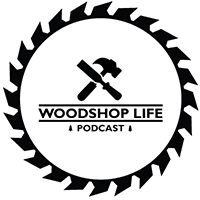Guy’s Questions:
Hi all: First, I love the podcast. I listen to several others as well. This is by far the best, the Premier podcast on woodworking. Your focus on the questions is outstanding. I know that you repeat yourselves often but it it is so helpful to those of us that are trying to learn the craft. I learn something every time I listen. Thanks! My question has to do with spraying a finish. I just bought my first HVLP sprayer. I’ve watched many of the YouTube videos on the basic process with regard to how to tune the gun and the process and motion of applying the finish. Many of the finishes today, especially water based finishes, dry very quickly. So what do you do between coats? Do you always breakdown and clean the gun and all of the other components? Is there some tricks that you use to keep the gun clean and ready for the next coat, without breaking it all down and starting a new? Thanks again, Joe
Hey guys. I’ve been watching all the New Yankee Workshop episodes as they’re being released on YouTube lately. Interesting to see how Norm did things back then, including how some of his techniques evolved over the years. One thing he almost always does is pin his tenons with dowels. I don’t see this much today unless it’s a draw bore, which I don’t see Norm do ever. (This pinning is almost always followed up with one of Norm’s favorite phrases, “That’s never coming apart!”) I guess the question is, should we be pinning tenons? Only in specific circumstances? Only if a draw bore? Peter
Infinity tools pro router table package with 3 1/4 Triton or a Grizzly G1035 shaper that can still run 1/2″ router bits. Always lots of talk about router tables but never anything about smaller shapers. I found this podcast a while ago and have made my way through all the episodes, I really appreciate all the great content, keep it up. Mike
Huy’s Questions:
Hey guys! I know you asked for more questions so I am going to try to help. I have a question about applying Odies Oil with a buffer. I’ve been using Odies because it’s too much work making a spray booth for spray finishing in my woodshop. I have applied Odies by hand with success but it’s a lot of buffing work. Gem buffers are pretty expensive, has anyone tried putting a hook and loop pad on a car buffer and just put a non woven pad on it? Big Cedar table Co.
Can you give any recommendations of hardwoods you enjoy to make furniture with? Alot of the furniture I’ve built in my house has been made from Walnut, White oak and cherry and am looking for something new. I’m looking to build some new furniture for my basement (tv stand, coffee table, maybe a dry bar to match species) but am looking for something new to use other than those stated above. Thanks for all you do. Paul Genereux at Twin Lake Woodshop
Hey, guys. Love the show. Appreciate the fact that you answer questions and although there is a little banter between the three of you, it doesn’t dominate the podcast as other shows do. I want to attend a “convention” for woodworkers and am curious if you have suggestions on what would be a good convention for woodworkers to attend. Thanks in advance! Greg
